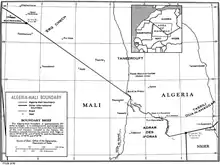Algeria–Mali border
The Algeria–Mali border is 1,359 km (844 m) in length and runs from the tripoint with Mauritania in the north-west to the tripoint with Niger in the south-east.[1]

Description
The border begins in the west at the tripoint with Mauritania, and is a continuation of the NW-SE straight line that forms the Algeria–Mauritania border.[2] This straight line runs for circa 752 km (467 m). Just north of the 21st parallel north the border shifts southwards, proceeding to the south-east via a series of irregular lines and the Tin-Zaouatene and I-n-Akantarer wadis, before turning to the north-east where a straight line connects up to the tripoint with Niger.[2] The border lies entirely within the Sahara desert.
History
France conquered most of northern Algeria during the period 1830-47, incorporating it as an integral part of France.[3] The 1880s saw an intense competition between the European powers for territories in Africa, a process known as the Scramble for Africa. The process culminated in the Berlin Conference of 1884, in which the European nations concerned agreed upon their respective territorial claims and the rules of engagements going forward. As a result of this. France gained control of the upper valley of the Niger River (roughly equivalent to the areas of modern Mali and Niger).[3] France occupied this area in 1900; Mali (then referred to as French Sudan) was originally included, along with modern Niger and Burkina Faso, within the Upper Senegal and Niger colony, however it was later split off and became a constituent of the federal colony of French West Africa (Afrique occidentale française, abbreviated AOF).[4][3]
In the meantime the French had been pushing south from the Algerian littoral, conquering much of the Algerian Sahara in 1902.[2][3] A boundary between French West Africa and French Algeria (i.e. Algeria’s modern borders with Mauritania, Mali and Niger) was agreed on 7 June 1905 by the Commandant of Upper Senegal and Niger and the Military Commander of the Department de l'Oasis within French Algeria.[3][2] The border was further defined by the Niamey Convention of June 1909.[2][3]
As the movement for decolonisation grew in the post-Second World War era, France gradually granted more political rights and representation for their sub-Saharan African colonies, culminating in the granting of broad internal autonomy to French West Africa in 1958 within the framework of the French Community.[5] Eventually, in 1960, Mali was granted full independence. The situation in Algeria proved much more difficult, owing to the large community of French settlers in Algeria, and independence was only granted in 1962 after a bloody war. At that point the Algeria–Mali border became an international frontier between two sovereign states.[2]
In recent years Algeria has boosted its military presence along the border owing to the instability in northern Mali as a result of the Mali War and the generally poor state of security in the Sahara region.[6][7][8]
Border crossings
The main border crossing is located between Bordj Badji Mokhtar (ALG) and Tessalit (MLI).[9] Travel to the border region is generally discouraged by third party governments at present owing to the poor security situation.[10][11]
See also
References
- CIA World Factbook – Mali, retrieved 17 January 2020
- Brownlie, Ian (1979). African Boundaries: A Legal and Diplomatic Encyclopedia. Institute for International Affairs, Hurst and Co. pp. 44–9.
- International Boundary Study No. 96 – Algeria-Mali Boundary (PDF), 16 March 1970, retrieved 17 January 2020
- Decree 7 September 1911, rattachant le territoire militaire du Niger au gouvernement général de l'Afrique occidentale française, published in the Official Journal of the French Republic on 12 Septembre 1911 (Online)
- Haine, Scott (2000). The History of France (1st ed.). Greenwood Press. p. 183. ISBN 0-313-30328-2.
- "Algeria beefs up army presence on Mali border". Al Jazeera. 5 February 2013.
- "Algeria, Mali discuss border security cooperation amid terror threats". Xinhua. 24 January 2019. Retrieved 28 January 2020.
- "UN Migration Agency in Mali Assists Over 1,100 Sub-Saharan Migrants at Algerian Border". ReliefWeb. 8 May 2018. Retrieved 28 January 2020.
- Ross Velton (2009) Bradt Travel Guide - Mali, pgs. 52
- British FCO Travel Advice - Algeria, 28 January 2020
- Australian DFAT Travel Advice - Algeria, 28 January 2020
